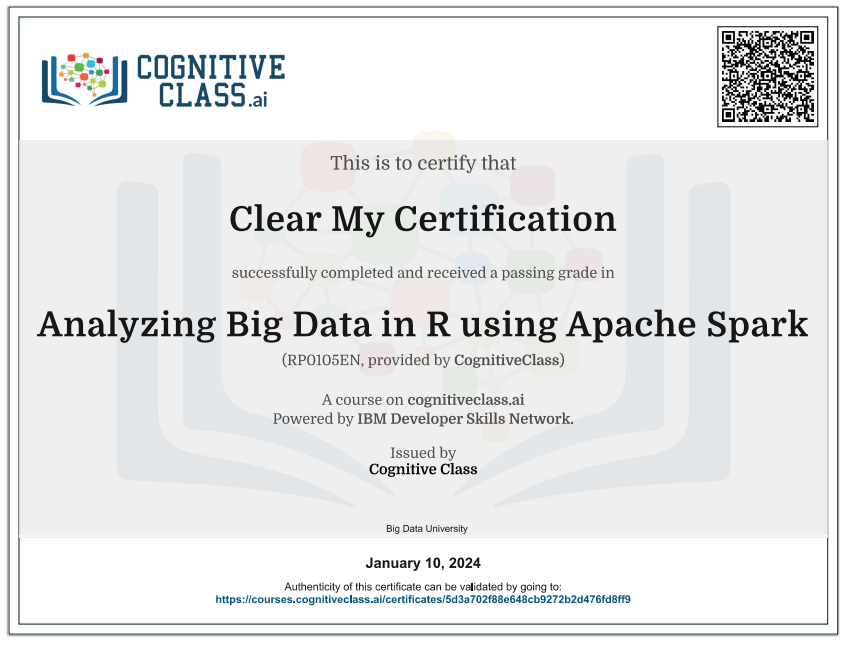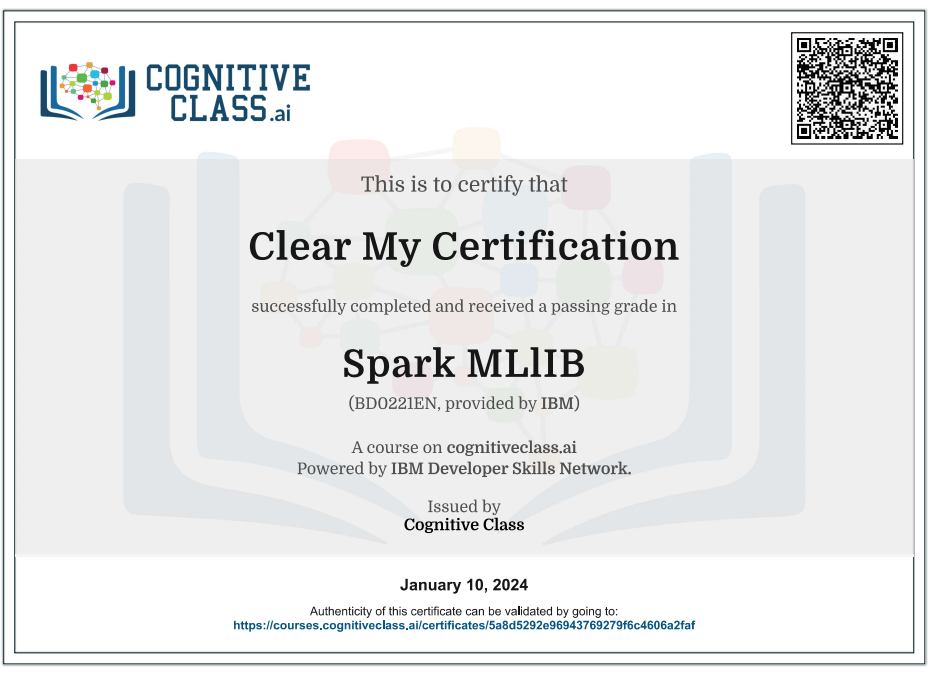Enroll Here: Fundamentals of Encryption & Quantum-Safe Techniques Cognitive Class Exam Quiz Answers
Fundamentals of Encryption & Quantum-Safe Techniques Cognitive Class Certification Answers

Module 1: Introduction to Encryption Quiz Answers – Cognitive Class
Question 1: According to the referenced report, what is the average cost of a data breach?
- $300K
- $10M
- $1.87M
- $4.35M
Question 2: What type of encryption uses the same key to both encrypt and decrypt the data?
- Public key encryption
- Private key encryption
- Same key encryption
- Single key encryption
Question 3: In what year was 56bit DES encryption broken?
- 1998
- 1978
- 2000
- 1988
Question 4: Encrypted data is also known as what?
- Gibberish
- Encrypted text
- Cypher text
- Plain text
Question 5: Why did a South African bank have to replace 12 Million bank cards?
- An insider shared all of the card numbers and their associated PINs
- Hackers stole their PIN numbers
- Hackers stole the card numbers
- An insider gained access to the bank’s master encryption key
Module 2: The Quantum Era and Quantum Computers Quiz Answers – Cognitive Class
Question 1: What is the gold standard for public key encryption today?
- DES 512
- RSA 4096
- AES 256
- RSA 2048
Question 2: Which of the 4 finalist algorithms as selected by NIST is hash based?
- SPHINCS+
- CRYSTALS-Dilithium
- FALCON
- CRYSTALS-Kyber
Question 3: True or false, AES 128 is currently considered to be Quantum-safe?
- True
- False
Question 4: How does Grover’s algorithm impact the strength of an encryption key?
- It decreases it by 75%
- It doubles it
- It quadruples it
- It cuts it in half
Question 5: A qubit is like doing what to a coin?
- Cutting it in half
- Doubling it
- Spinning it
- Flipping it
Module 3: Safeguard your Data with Quantum-Safe Cryptography Quiz Answers – Cognitive Class
Question 1: Peak visibility is achieved by analyzing what?
- Logs and metrics
- Logs, metrics, and traces
- Metrics and traces
- Logs and traces
Question 2: Cryptographic agility requires which of the following?
- An architecture that can evolve over time
- The ability to suppprt both Quantum-safe algorithms and current algorithms
- A web service based architecture
- Quantum-safe algorithms
Question 3: Which of the following is NOT one of the ways to build a cryptographic inventory?
- Run time tracing
- Manual discovery
- Static scanning
- Extraction from key management tools
Question 4: What are the two types of data discovery?
- Manual and Application
- User and Automated
- Manual and Automated
- User and Application
Question 5: Y2Q is also known as what?
- Q-Day
- Quantum-safe
- Years before Quantum computers
- Years to Quantum computing
Fundamentals of Encryption & Quantum-Safe Techniques Quiz Answers – Cognitive Class
Question 1: Which of the following is NOT one of the steps in the encryption key management lifecycle?
- Rotation
- Reinstatement
- Creation
- Revocation
Question 2: The longer an encryption key is used, the more data it is likely protecting, which does what to the value of that key to attackers?
- Negates it
- Has no impact
- Increases it
- Decreases it
Question 3: What are the 3 main types of key management systems?
- Native, local, and global
- Localized, centralized, and decentralized
- Native, non-native, and global
- Native, localized, and centralized
Question 4: According to the referenced report, what is the average cost of a data breach?
- $4.35M
- $1.87M
- $300K
- $10M
Question 5: What can NOT happen if current cryptography (encryption) is broken?
- Data becomes more secure
- Change history
- Launch extortion attacks
- Create fake identities
Question 6: On January 15, 1977, the NBS adopted the first-ever Data Encryption Standard (DES) for the United States, and the world would soon follow. Who created this algorithm?
- Microsoft
- NIST
- IBM
Question 7: Digital signatures, like those used to sign legal documents online, are based on what?
- Least trust coordination
- Private keys
- Quantum-safe algorithms
- Public keys
Question 8: What does the HTTPS indicate in a website URL?
- The website name has been encrypted
- There are multiple websites with the same IP address
- There are multiple websites with the same URL
- The website is secured using SSL/TLS
Question 9: What is the gold standard for public key encryption today?
- DES 512
- RSA 4096
- AES 256
- RSA 2048
Question 10: Which of the 4 finalist algorithms does NIST recommend as the primary algorithm for digital signatures?
- FALCON
- CRYSTALS-Dilithium
- SPHINCS+
- CRYSTALS-Kyber
Question 11: Which of the 4 finalist algorithms as selected by NIST is the largest and slowest?
- FALCON
- CRYSTALS-Dilithium
- SPHINCS+
- CRYSTALS-Kyber
Question 12: Which algorithm can be used on a Quantum computer to crack today’s public key encryption?
- Pythagorean Theorem
- Mosca’s Theorem
- Shor’s Algorithm
- Grover’s Algorithm
Question 13: A 4 qubit machine can represent how many bit combinations at the same time?
- 16
- 4
- 1024
- 1
Question 14: According the Michele Mosca, what is the probability that public key encryption will be broken by the year 2031?
- 1 in 1000
- 1 in 5
- 1 in 7
- 1 in 2
Question 15: Today’s most widespread encryption protocols rely on which of the following to provide cybersecurity?
- VPNs
- The memory limits of classical computers
- Firewalls
- The computational limits of classical computers
Question 16: Which of the following is NOT one of the ways to build a cryptographic inventory?
- Run time tracing
- Manual discovery
- Static scanning
- Extraction from key management tools
Question 17: A DevSecOps model allows security teams to do what?
- Change data encryption throughout the software development lifecycle
- Implement and monitor data encryption throughout the software development lifecycle
- Monitor data encryption throughout the software development lifecycle
- Implement data encryption throughout the software development lifecycle
Question 18: What open source project provides a common API today for testing and prototyping?
- The Quantum Safe Security (QSS) project
- The Open Quantum Safe (OQS) project
- The Post Quantum Safe (PQS) project
- The Quantum Security (QS) project
Question 19: Which of the following is NOT part of a cryptographic inventory?
- Algorithm
- Key Length
- Owner
- Key
Question 20: Organizations can examine their hardware security modules to find encryption information. What approach to finding cryptography is this considered to be?
- Static scanning
- Run time tracing
- Automatic
- Manual
Question 21: In order to be valuable, a crptographic inventory needs to be ________.
- Compiled into the application
- Shared with the CSO
- Appended to the data catalog
- Kept up to date
Question 22: Which of the 4 milestones to becoming Quantum-safe can be started today?
- None
- Only Preparation
- Preparation, Discovery, and Transformation
- Preparation and Discovery
Question 23: As you add qubits to a Quantum computer, it’s power increases how?
- Incrementally
- Proportionally
- Fractionally
- Exponentially
Question 24: Which of the following is NOT one of the states that data can be in?
- In use
- At rest
- In motion
- On the cloud
Question 25: Which of the following is most well known for securing data at rest today?
- GDPR encryption
- RSA encryption
- SSL/TLS encryption
- AES encryption
Introduction to Fundamentals of Encryption & Quantum-Safe Techniques
Fundamentals of Encryption:
Encryption is a fundamental technique used to secure sensitive information by converting it into an unreadable format that can only be accessed or deciphered by authorized parties who possess the corresponding decryption key. Here are the key fundamentals of encryption:
- Key Concepts:
- Plaintext and Ciphertext: Original, readable data is called plaintext. When encrypted, it becomes ciphertext, which is not easily understood without the decryption key.
- Encryption Algorithm: The mathematical process or set of rules used to convert plaintext into ciphertext.
- Key: A secret parameter used by the encryption algorithm. The security of the encryption system relies on the strength of the key.
- Symmetric Encryption:
- In symmetric encryption, the same key is used for both encryption and decryption. It is fast and efficient but requires a secure method of key exchange.
- Asymmetric Encryption:
- Asymmetric encryption involves a pair of keys: a public key for encryption and a private key for decryption. This eliminates the need for a secure key exchange but is computationally more intensive.
- Hash Functions:
- Hash functions generate fixed-size output (hash) from variable-size input. They are commonly used for data integrity verification and password storage.
- Key Management:
- Effective key management is crucial for the security of encrypted data. This includes key generation, distribution, storage, and rotation.
- Common Encryption Algorithms:
- Examples include Advanced Encryption Standard (AES) for symmetric encryption and RSA, Elliptic Curve Cryptography (ECC), and Diffie-Hellman for asymmetric encryption.
- SSL/TLS Protocols:
- Secure Sockets Layer (SSL) and Transport Layer Security (TLS) protocols are widely used for securing communication over the internet, ensuring data confidentiality and integrity.
Quantum-Safe Techniques:
With the advent of quantum computers, certain algorithms used in classical encryption may become vulnerable. Quantum-safe or post-quantum cryptography aims to develop encryption techniques that remain secure even against the computational power of quantum computers. Here are key concepts:
- Quantum Computing Threat:
- Quantum computers, when fully developed, could efficiently solve certain mathematical problems, such as integer factorization and discrete logarithms, which are the basis of some widely used encryption algorithms.
- Quantum Key Distribution (QKD):
- QKD is a method that uses the principles of quantum mechanics to secure a communication channel. It allows two parties to produce a shared random secret key, which can then be used for secure communication.
- Post-Quantum Cryptography:
- Post-quantum cryptography refers to cryptographic algorithms that are believed to be secure against quantum attacks. These include lattice-based cryptography, hash-based cryptography, code-based cryptography, and more.
- NIST Post-Quantum Cryptography Standardization:
- The National Institute of Standards and Technology (NIST) is actively working on standardizing post-quantum cryptographic algorithms to ensure the security of information in the post-quantum era.
- Transition Plans:
- Organizations are encouraged to develop transition plans to migrate from existing cryptographic algorithms to quantum-safe alternatives as they become standardized.
- Quantum-Safe Hybrid Cryptography:
- Hybrid approaches involve combining classical and quantum-safe algorithms. For example, using traditional encryption for confidentiality and QKD for key distribution.
- Quantum-Safe Best Practices:
- Organizations should stay informed about developments in quantum computing and regularly assess their cryptographic systems to ensure they remain secure.
The landscape of encryption is evolving, and it is essential for organizations to adopt encryption best practices while also preparing for the potential impact of quantum computing on cryptographic systems in the future.
 Clear My Certification All Certification Exam Answers
Clear My Certification All Certification Exam Answers



